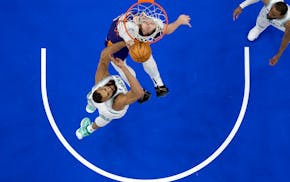GULLANE, Scotland — Garry Harvey may have the most famous hands in golf.
Anyone who's watched the closing moments of the British Open has seen them, the calluses on the right index finger and thumb telltale signs that he's played his share of golf. But there's another reason. Like his father before him, Harvey is the man who engraves the name of the winner on the base of the claret jug.
Asking the 58-year-old, soft-spoken Scotsman to pick a favorite out of the field elicits little more than a wry smile.
"Preferably a short name," he said, "with a four-shot lead."
The Open granted one of those wishes last year, when Ernie Els lifted the slim silver trophy aloft on the 18th green at Royal Lytham. The only drawback is that Harvey couldn't put pencil to metal — he traces the name before etching so much as a line — until Adam Scott's 7-foot par putt on the last hole slid past the cup just moments earlier.
"You usually only have five to 10 minutes max to do the deal and cram it all in," he said.
That's working at a pace of roughly 15 seconds per letter, always with at least one TV camera looking on and occasionally, with Royal & Ancient chief executive Peter Dawson peering over his shoulder.
"The size of the name can be a problem," he said. "I remember father having a bit of trouble — not trouble, he never had any trouble — but it was a push to get Severiano Ballesteros done. That's a lot to go on there."
Harvey has had his share of close calls as well. He served a seven year on-and-off apprenticeship to his father, Alex, carving out a modest career on the European Tour in between. He won exactly one tournament, the Kenyan Open in 1985, and qualified for the Open in 1979, the same year Ballesteros won. Harvey was almost reluctant to admit he dared imagine his father engraving his name on the claret jug instead of the Spaniard's that year. That dream died in a hurry.
"Until my first lost ball," Harvey said.
He would up shooting 82-80 and missing the cut. With his father's health slipping, Harvey took over the engraving duties at the Open full-time in 2004. He broke the ice with Todd Hamilton and has had both Tiger Woods and Padraig Harrington twice. He figures he was lucky that Harrington ("17 letters, I know that by heart") won in back-to-back years.
Harvey wears a jeweler's eyepiece and works with five different edged gravers — wood-handled tools that resemble small screwdrivers — including one that belong to his father. The skills required have changed little through the centuries and not at all since the Harveys, who did a variety of jobs for the R&A down the years, were asked to begin engraving the claret jug on-site in 1968.
The impetus came when 1967 Open champion Roberto diVicenzo returned the trophy that year without having his name engraved. Previously, that was the responsibility of the winner. The first name Alex was charged with over his 33 years at the Open was an easy one, Gary Player — though it's so much larger than all the rest that he must have felt some pressure at the moment.
"It's huge," Harvey chuckled. "But yes, you do feel a bit of pressure, especially when Peter is standing behind you.
"There used to be one cameraman, nowadays seems to be two. But if you concentrate," he added, "you're fine. What I did find one time, we had a monitor beside me and I could hear (BBC announcer) Peter Alliss commentating (on the engraving), and that caught my attention. I said, 'Well, we're not going to have that in there anymore."
Harvey finds himself facing a different sort of pressure on the golf course occasionally, playing mostly in senior tournaments at home and on the continent. He's qualified for one British Senior Open and will try to make a second beginning Monday, after his duties here are finished. Even so, that pressure pales by comparison to the tight spot his father found himself facing at Carnoustie in 1999, when Jean Van de Velde arrived at the 18th tee with a three-shot lead he would squander in spectacular fashion — before losing a three-way playoff.
"Where you're meant to start is the biggest problem," Harvey recalled. "When Paul Lawrie won in '99, we had two or three names already penciled in.
"Van de Velde had a disaster. If he had cleared the burn," Harvey recalled, "we could have started engraving the name."
NFL draft has been on tour for a decade and the next stop is Detroit, giving it a shot in spotlight

Souhan: Wolves fans made Game 1 special. Now bring on Game 2.

Will Wolves show best-in-the-NBA defensive form in Game 2?

Former Totino-Grace star set to follow father as first-round pick

